
Tibet
26,335 feet 8,027 meters
|
|
 |
Shishapangma Tibet 26,335 feet 8,027 meters |
||||||||
|
|||||||||
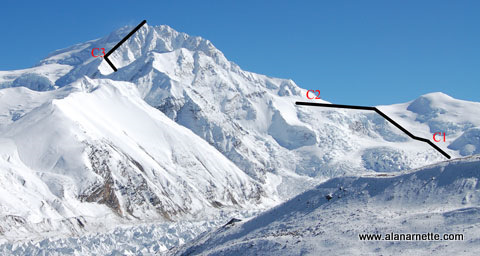 Shishapangma is the 14th highest peak in the world at 26,335 feet or 8,027 meters.
It is located in southern Tibet and uniquely stands somewhat alone from
the main Himalayan range. The expedition met in Kathmandu, flew to Lhasa
and then drove over the Tibetan Steps to our base camp. The six week expedition
was my fifth climb on an 8000m mountain. Shishapangma is the 14th highest peak in the world at 26,335 feet or 8,027 meters.
It is located in southern Tibet and uniquely stands somewhat alone from
the main Himalayan range. The expedition met in Kathmandu, flew to Lhasa
and then drove over the Tibetan Steps to our base camp. The six week expedition
was my fifth climb on an 8000m mountain.We took the "normal route" for the climb. After spending almost 10 days getting to Nepal then Lhasa, we drove to the Chinese base camp at 16,400', and took 5 nights, 4 days to further acclimatize in mid September. Next we moved to Advanced base camp with Yaks doing the heavy loads. ABC was at 18,500'. Altitudes and Distances: base camp (BC) 5000m, 16,400 feet: BC - ABC 9 miles, 6 hours start of trip, 4 hours end of trip Advanced base camp (ABC) 5600m, 18,375 feet: ABC - C1 3.7 miles, 8 hours first time, 6 hours thereafter (one way) C1 6400m, 21,000 feet: C1 - C2 .6 miles, 4-5 hours C2 7100m, 23,300 feet: C2 - C3 .6 miles, 3-5 hours C3 7500m, 24,600 feet: C3 - Summit .6 miles, 7 hours 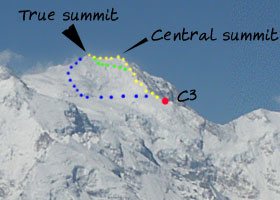
The actual climbing finally began after more than two weeks. We used the second half of September for "climb high, sleep low" acclimatization climbs to Camp 1 at 21,000' and Camp 2 at 23,300'. Most of the route was snow. It was generally safe to Camp 2 but there were some big crevasses. The summit bid was scheduled to start after a rest break back at ABC but a good weather window never materialized. The plan for the bid, was to return to C1 and C2 then climb the steep slope to Camp 3 at 24,600'. From C3, we were to go for the summit. Shishapangma has a false summit at 26,286' or 8012m but we wanted to go for the true summit at 26,335' or 8027m. The climb from C3 is steep but not too difficult. To the true summit, we would have either had to negotiate a knife edge traverse or take a slightly longer route that has crevasse danger. Two people on another team summited in 2007 and no one else to my knowledge due to heavy snows and dangerous conditions on both side of Shishapangma. My next climb is Aconcagua in January 2008. Shishapangma Sometimes being the smallest doesn’t make you the weakest. Shishapangma, the shortest of the fourteen 8000 meter mountains, is one tough competitor! Fall of 2007 was another season that few climbers (two to be exact) stood on the Central Summit and none on the Main (true) summit. My Shisha climb was designed to test myself on an 8000m mountain as I traveled down my Memories are Everything®: The Road Back to Mt. Everest journey. The primary purpose was to raise money for Alzheimer’s research. This was my fifth climb on an 8000m mountain and my first to Shisha. I met up with my team organized by Jamie McGuiness of Project Himalaya in Kathmandu in early October 2007. We left the next day for some sight seeing and a leisurely acclimatization process via Lhasa, Tibet. I was excited to see Lhasa since I had read about it for ages and wanted to see for myself if it had held onto its legendary status. Flying over the Himalaya in the modern China Airlines Boeing 737 was
exciting. I looked down over the tallest mountains on the planet with
a sense of appreciation and nervousness. As we entered Lhasa air space,
the landscape took on the personality of rugged foothills, expansive
flat plains and, of course, Monasteries. Lhasa’s primary road from the airport was a scene from any US or European modern city. Large retail stores and car dealerships lined the extra wide boulevard along with modern street lamps and traffic signals. Soon we arrived at our modern hotel, complete with high speed internet service. My goal was to see the home of the exiled Dali Lama – The Potala Palace. I had seen pictures but had no idea of its context in modern times. The reality was a mixture of pleasure and sadness. The Potala is one of the most impressive structures I have ever seen and that include all the most modern buildings such as the Petronas Towers in KL, the new Dubai skyline and the Taipei 101. To think it was built of mud, straw and tree trunks almost 1400 years ago! The red section was for the religious leaders and the white for government. It served as the home of Buddhism for centuries until the 1950 “Cultural Revolution“ in Tibet. Today it is more of a museum and serves as a building for Chinese officials. Literally thousands of visitors, predominantly the new Chinese middle class, tour the Potala daily. Monks still live there but mostly to answer visitor questions and to guard the precious displays in the hundreds of rooms. 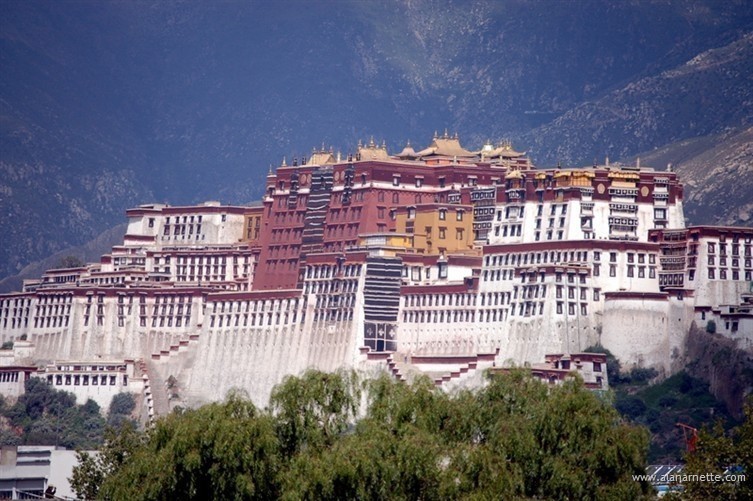
It would take days to go through the Palace but with so many visitors, each group is limited to only two hours. We scurried from the halls and chapels and shrines of past Dalai Lamas seeing gold and jeweled covered models, artwork and carvings. The tomb of the 13th Dali Lama is also there. Each room held more unbelievable artifacts than the previous. Much of the Palace is closed to visitors. Sadly, across the street and visible from each front window of the Palace is an immense concrete park holding a tall thin modern steel tower – modern art if you will – I assume erected by the Chinese officials to “balance” the power of the Potala. In reality it looked silly and desperate. The Chinese army stood guard over the park to prevent vandalism. Next was a visit to the Jokhang Temple the spiritual center of Tibet. It was built in 647AD and is the oldest temple in Tibet. Every year, millions of pilgrims make a long pilgrimage to Jokhang. The famous Barkhor Street was where pilgrims prostrated themselves and moved around Jokhang Temple. Today, Tibetan people still follow this custom, moving clockwise around Jokhang Temple every dawn and dusk. Finally, we visited the summer home of the Dali Lamas, also in Lhasa, the Summer Palace of the Norbulinka. This was a quiet and peaceful park covered with flowers, grass and trees. It held numerous small Palaces which served as the summer residence for the Dali Lamas. They were somewhat unique according to the tastes of each Dali Lama and still held the original furniture and furnishings. We left Lhasa and began our journey to the Shishapangma base camp (BC). This involved a three day drive with stops at the cities of Shegar and New Tingri. The road went from decent paved surfaces to gravel roads to pure dirt. The stops were not all that interesting but we gained altitude along the way. Lhasa is around 11,000’ and BC was 16,500’.
As we got closer to Shisha BC and gained altitude, the landscape turned more barren. Soon we could see snow covered mountains that served as back drops to the now pure agriculture based villages and the occasional Nomad tents. It felt like we were literally gong back in time. base camp was on the edge of a glacier melt stream and sat on a soft bed of natural grass. We could easily see Shishapangma about 20 miles away. This was around 16,500’ so we spent an additional 5 days here to acclimatize. Days were spent climbing to nearly 20,000’ on nearby hills. They reminded me of some of my Colorado 14ers being walk-ups on tundra covered hillsides. But the views were simply astounding. We could clearly see the glaciers traveling off the Shisha Massive as well as huge lakes on the Tibetan landside. The nights were spectacular as well. With the closest city being Kathmandu, 60 miles to the south and over the Himalayas, there was no ambient light – none, zero. The stars shown like street lights and the Milky Way streaked across the sky like a brightly lit rainbow. Stunning. Some other teams were already at BC - Russians, the British Army and some independents. Yaks seemed to come and go in support of the teams arriving and then departing for ABC. It was great to see these huge furry beasts. They may look like hairy cows but are their own breed. They have the disposition of a Hollywood starlet being asked to move her car from the front of a club and snort the same way! The yak herders know how to handle their beasts and fight back during the entertaining show of tying our blue barrels or sacks of food on their backs. As usual the gear was loaded and the yaks on their way after a few hours of tug-a-war. The walk to Advanced base camp (ABC) was along a glacier stream but soon simply followed a worn trail across the high plains. The wind was ever-present and kept things cool. We carried only a light day pack with our lunch and a jacket or two. The snow covered peaks got closer and closer. Soon we made our way over the last small hill and arrived in what was to be our home for the next four weeks. And of course Shishapangma stood high at the end of the glacier, directly ahead! It was quite a view. 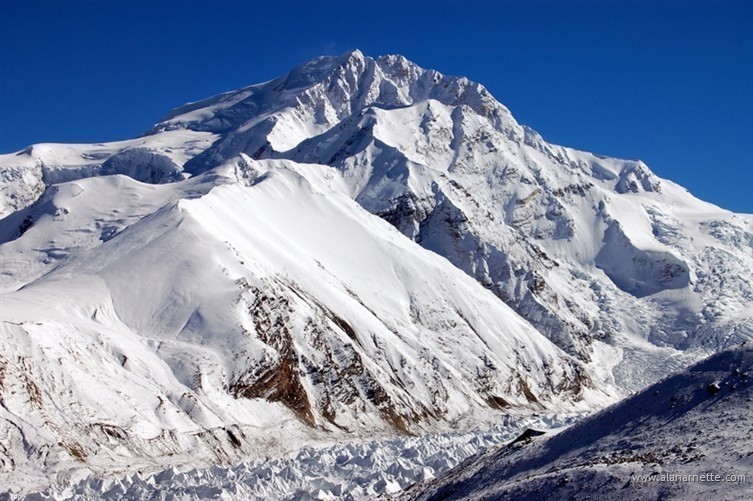
All of tents, food and gear were still on 50 or more yaks down valley thus we settled in to enjoy an improvised series of meals. The yaks soon arrived; tents were set up, sleeping bags laid out and home was set. The first order of business was to have the Puja. It is required before anyone - climbers or Sherpa - set foot on the Hill. This is one of my favorite parts of any Himalayan climb. The Puja (poo-ja) is a ceremony performed by the Sherpa or a local Lama to ask forgiveness from the mountain for the holes created by our crampons, ice axes and other sharp items. Also it is to ask for permission and safety from the Mountain Gods to climb the mountain. The ceremony last about three hours and starts by spreading prayer flags in four directions from a rock alter. Prayers are read from century old Tibetan prayer books while juniper boughs are lit. The smoke gently spreads across the camp with the comforting sound of chanting in the background. Everyone sips hot tea and sits in their sock feet, crossed legged in front of the alter. 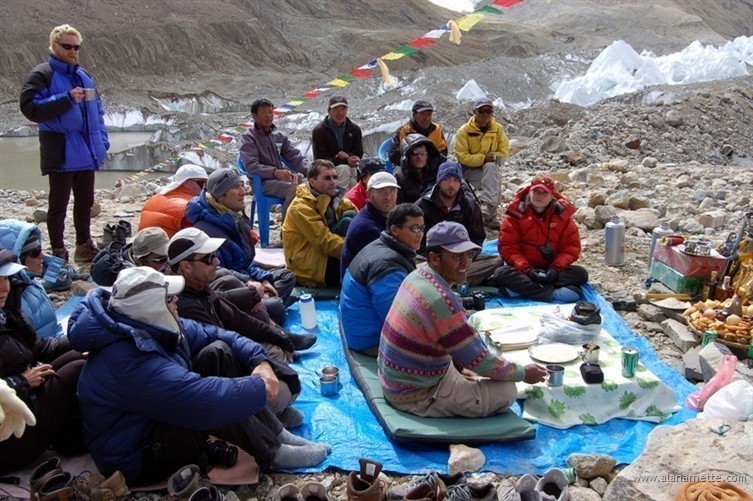
At one point in this Puja, each climber took a pinch of rice and wrapped it in a small piece of cloth. We then tied it on the line holding the prayer flags. What each person thought as they performed this part was personal and private. But I am sure it was as meaningful for them as it was for me. Towards the end of the ceremony, a bottle of whiskey is brought out and most everyone has a shot or two (or three) along with some beer and a party erupts. Bonds are made and everyone begins to think of the climb. Over the next few days, the Sherpa carried tents to 21,000 to establish Camp 1 on the slopes of the Shishapangma massif. In groups of 5 or 7 we all left ABC to spend a night at an interim camp named Depot camp. It sat at the edge of the Glacier and on the sloping scree of a hillside. It was quite uncomfortable but a necessary stop on the acclimatization process. It was at 19,000. The glacier crossing involved a series of up and down climbs of tall ice towers called penitentes. These ice sculptures are formed by the movement of the ice along with the melting from the sun. They form a series of towers that span the glacier both sideways and downstream. We left Depot with full packs of sleeping bags, clothes plus some food and water. Wearing our heavy boots, crampons, harnesses and carrying ice axes we were loaded! It took about an hour and half for that first trip. 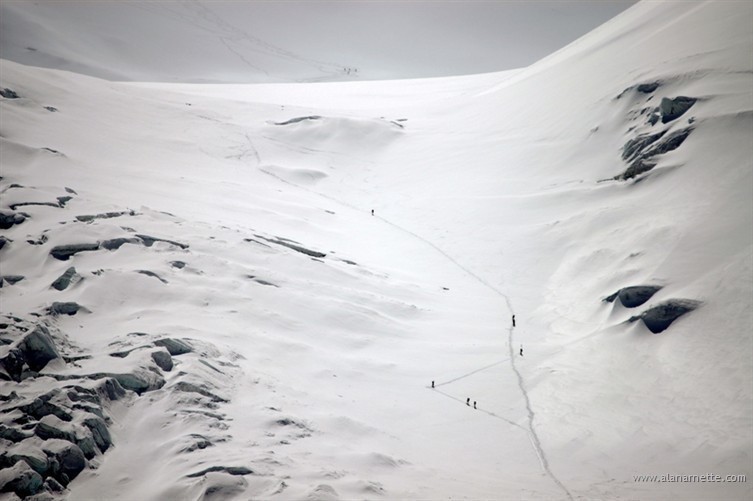 On
the other side, we started the climbing proper with a long climb up a gentle
snow slope. It was more like a ski run in that it was a wide section of
the mountain that was smooth on a 20 degree angle. But it was over 20,000’ and
with our heavy loads and heat of the sun, soon everyone was moving steady
but slow towards Camp 1. On
the other side, we started the climbing proper with a long climb up a gentle
snow slope. It was more like a ski run in that it was a wide section of
the mountain that was smooth on a 20 degree angle. But it was over 20,000’ and
with our heavy loads and heat of the sun, soon everyone was moving steady
but slow towards Camp 1.
The angles steepened somewhat as we approached the top of a small ridge on the slope but then flattened out as I saw two sets of tents. Of course ours was furtherest away! I was tired when I arrived and glad to be there. The Sherpa had already set up some tents so I crawled in one awaiting Martin, my tent partner. He had been moving a little slower than I did so I started to melt snow so we would have water for rehydration. I laid out my insulating pad, thin air mattress and down sleeping bag. I was glad I did since as soon as the sun dropped behind the mountains the temperature dropped dramatically. I put on my down jacket and crawled into my bag as I watched the melting snow. We spent the next day resting at Camp 1. The day consisted of mostly sleeping, listening to our iPods, taking a short walk to get the blood flowing and, of course, melting more snow! The random good natured fights about who was crossing the imaginary “center line” made the day go by fast. 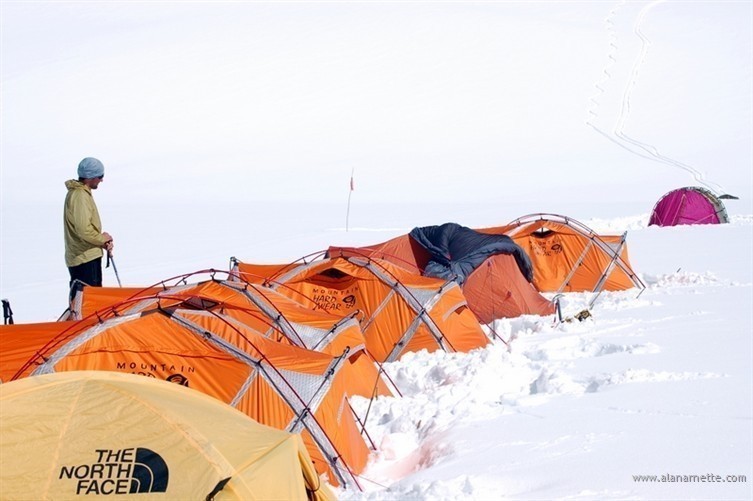
Two nights at Camp 2, nearly 23,000, was the next milestone. The actual naming of the camps on Shisha is more of an estimate since the camp we established was referred to as Camp 1.6 since it was few hundred feet of the normal Camp 2 but all purposes it was close enough for me to call it Camp 2. We left Camp 1 with full packs and headed up the now steep slopes. The terrain was similar to our climb to Camp 1 but at a 40 degree angle. There were a few crevasses but nothing so wide that it posed an immediate danger. Fixed ropes were set across a small band of these and we clipped a carabineer onto the rope for extra safety but we never roped up to one another. After four to six hours we arrived at the next camp. This time the tents had not been established so we set them up and started to melt snow. A similar pattern to Camp 1, we rested and took short walks for further acclimatization. I took a walk to 7,000 meters or about 23,000 feet. From there I called in an audio dispatch. The view was incredible - one of the best in all my climbs – ever. 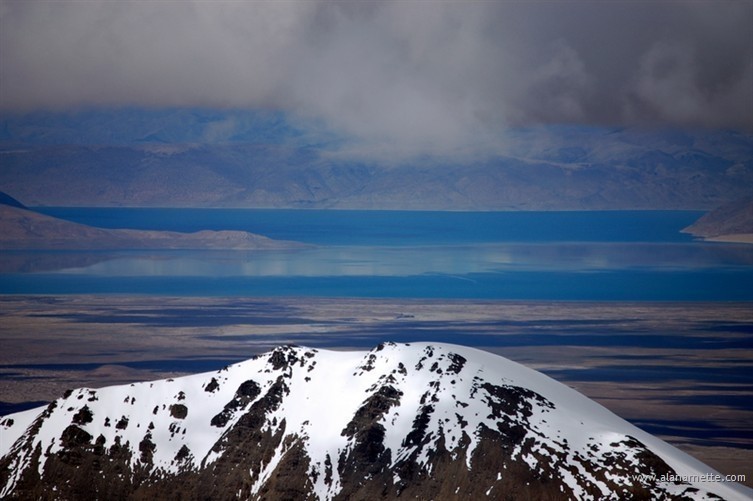
I quietly sat on the white snow looking out over the brown Tibetan plains. A clear blue sky just above was blocked by the occasional white cumulonimbus cloud. It was a scene that Van Gough would have loved to have painted. Behind me stood the summit of Shishapangma – only 3,000’ higher than where I sat, it was rocky and snow covered. A slight plume came off the summit as the high winds continued to leave their mark. It was an awe inspiring and yet ominous sight. After two nights at Camp 2 and 2 nights at Camp 1 we descended back to ABC for a period of rest. Also we were anxious to get the weather forecast since clouds had moved in and it had started to snow as we entered ABC. The weather began an unpredictable period. For the next four days it snowed heavily. The forecast from several sources showed the pressure dropping and the winds strong high on the mountains. It became clear that we would stay at ABC longer than planned. The days were passed with a steady diet of great food. Meals became the social events of the day with washing, napping and reading to fill the gaps. Emails were a highlight but with all the cloud cover, it was a challenge to keep the batteries charged from the solar panels. 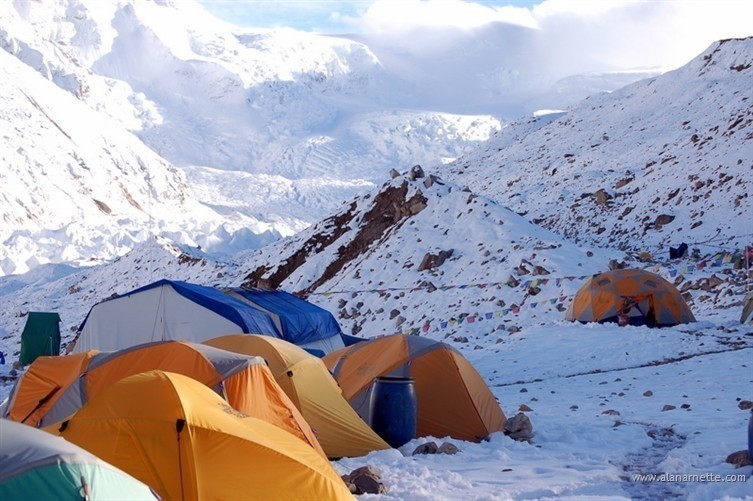
The nights were cold thus filing our water bottles with hot water became a priority at the end of each night’s dinner. The hot bottle gave a nice jump start to the cold sleeping bag. After six nights, Jamie announced that he wanted as many people as possible to return to Camp 1 for the activity and acclimatization. This made good sense to me but one thing was missing – a long-term weather forecast that we could count on. Most people had flights out in about two weeks so the time was getting to be short to make a climb to camp1, return to ABC, rest and then return for a summit bid. Also, this would have made a stressful physical schedule. I made my own decision not to go up with everyone else but to stay behind at ABC and take day hikes to 20,000’ for activity and acclimatization. Thus the scene was set for the next few days. Each morning we would go on the Internet via Jamie’s Bgan satellite modem to look at a few weather websites. Also we received daily forecasts and, more importantly, interpretation, from Michael Fagen in the US. For the next hour we would discuss the data and try to formulate the next steps. I really enjoyed having Andrew Lock along. Andrew is Australia's most accomplished climber. He was using Jamie’s logistics for his attempt on Shisha’s true summit. This was his fifth time to the Hill with the previous climbs as a guide. But this was for himself and would be his 13th 8000 meter summit. His calm demeanor and deep experience made for interesting dinner conversation. Soon there were climbers all over the mountain. Some were at the Depot camp, a few at Camp 1 and a small team of three plus two Sherpa at 7000m. However the strong winds returned along with some snow and clouds. Everyone sat tight waiting for a break. The clock was ticking. 
Finally, we saw a small window for October 10th. There were two other climbers plus Jamie and the majority of the Sherpa at ABC. We all prepared for the mad dash to Camp 1 to get in position should the forecast hold true. I packed my down suit and headed up with Tristin, an impressive young man from Scotland. We met up with Eric and Jen at depot camp and crossed the penitentes together in a reasonable 45 minutes – half the original time. The winds picked up as we started the slope to Camp 1. It was cold. Tristin, leveraging his 18 year-old strength, moved steadily up the hill. Jen, Eric and I followed at a slightly slower pace. We could see climbers descending, some apparently on skis for the first time! The wind grew stronger as some clouds moved overhead. I felt good but not great. I slowed a little as Jen drafted on the heels of Eric, a professional guide. Soon I was beyond hearing distance as the winds were now creating ground blizzards. The sun dropped behind the mountains to my right making the temperature drop by 20 degrees. Now I had my full down jacket and Gortex on. My thoughts went to the likelihood of a summit attempt in such conditions. I was about two-thirds of the way to Camp 1 when I started to feel fuzzy. Not a good description but that is the best I have. I stopped for a while and had some water and food. I continued my climb in the brutal winds. Overall I felt good but there was something developing that bothered me. I went through my mental check list: hydration, nutrition, warmth, strength, reserves … Then it was clear that I should go down. There was nothing specific but I felt like it was the right thing to do. I knew there might be another chance for a summit bid but I really didn't dwell on it. I know this all sounds spacey and spiritual but it was a feeling. So that is what I did.
At this point many of our team who had gone up almost a week earlier had returned to ABC. For the next two days we monitored our brave summit team of five at 7000m. Anticipating the infamous window, they rose early one morning for the summit only to call it as high winds and clouds moved across the ridge to the summit. The expedition was over. All in all, I call my climb a success. In spite of my fuzzy return, I felt great. I made it to 7000m or 23,000’ feeling excellent. Upon reflection, my decision to return to ABC instead of going higher to Camp 1 was the right call for me. I have learned to trust my intuition and to think clearly in the worst of situations. The fund raising for the Cure Alzheimer’s Fund was low but every donation was appreciated. I hope that more interest around Everest will result in higher donations plus I have a few plans to encourage people to donate. Shishapangma may be the lowest 8000 meter mountain but she is no walk-up.
The Tibetans name of Shishapangma is translated as “crest above
the grassy plain". The Chinese call it Xixabangma which is translated
to mean "bad weather" or "severe climate". I think
they are both right! Please browse and enjoy these pictures I took on the expedition. Click on each image to take you to the gallery:
|
|